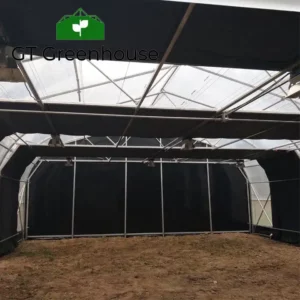The choice of blackout system in a greenhouse can significantly influence its overall climate resilience, affecting the structure’s ability to withstand and adapt to varying environmental conditions.
Here’s how the choice of a blackout system contributes to the climate resilience of a Blackout Greenhouse:
- Material Durability:
- Impact on Longevity: The durability and resilience of blackout system materials impact the longevity of the greenhouse. High-quality blackout materials that are resistant to wear, tear, and degradation contribute to the overall structural integrity, ensuring a longer lifespan and better climate resilience.
- Weather Resistance:
- Performance in Adverse Weather Conditions: The blackout system’s ability to withstand adverse weather conditions, such as heavy rain, strong winds, and snow, is crucial for climate resilience. Robust blackout materials and mechanisms ensure continued functionality and protection of crops even in challenging weather scenarios.
- Wind Load Capacity:
- Wind-Resistant Design: The blackout system’s design and construction influence its wind load capacity. A well-engineered blackout system that can withstand high wind loads enhances the greenhouse’s resilience, preventing damage during storms or windy conditions.
- Temperature Regulation:
- Impact on Insulation: The blackout system’s design can influence its insulation properties. A blackout system with good insulation capabilities contributes to better temperature regulation inside the greenhouse. This, in turn, enhances the greenhouse’s resilience to temperature extremes and fluctuations.
- Moisture Management:
- Prevention of Water Ingress: The blackout system should be designed to prevent water ingress during rain or high humidity. Effective moisture management is essential for preventing damage to the structure and ensuring a resilient climate-controlled environment.
- Automation and Sensor Integration:
- Real-Time Adjustment to Conditions: Advanced blackout systems that integrate automation and sensors enhance climate resilience. These systems can respond in real-time to changing weather conditions, automatically adjusting blackout curtains or other elements to maintain optimal growing conditions.
- Snow Shedding Design:
- Preventing Snow Accumulation: In regions with snowfall, China Blackout Greenhouse suppliers the blackout system’s design should facilitate snow shedding to prevent excessive snow accumulation on the greenhouse roof. This feature contributes to the greenhouse’s resilience against potential snow-related damage.
- Resistance to UV Exposure:
- UV-Resistant Materials: UV-resistant coatings or materials in the blackout system protect against prolonged exposure to sunlight. UV resistance enhances the longevity of the blackout system and contributes to the overall climate resilience of the greenhouse.
- Adaptability to Different Climates:
- Versatility in Design: The adaptability of the blackout system to different climates is important for overall climate resilience. A versatile system that can be customized or adjusted to meet the specific needs of various climates enhances the greenhouse’s ability to thrive in diverse environmental conditions.
- Ease of Maintenance:
- Impact on Long-Term Performance: A blackout system that is easy to maintain contributes to the long-term performance and resilience of the greenhouse. Regular maintenance ensures that the system remains functional, preventing potential issues that could compromise climate control.
- Resistance to Corrosion:
- Material Selection for Frame and Components: If the blackout system includes metal components, selecting corrosion-resistant materials for the frame and other components enhances the resilience of the greenhouse against environmental factors like moisture and humidity.
- Energy Efficiency:
- Integration with Climate Control Systems: A blackout system that integrates seamlessly with energy-efficient climate control systems contributes to the overall energy efficiency and climate resilience of the greenhouse. This includes features such as automated ventilation and heating systems.
In summary, the choice of a blackout system is a critical factor in determining the climate resilience of a Blackout Greenhouse. It involves selecting materials, design features, and automation capabilities that collectively contribute to the greenhouse’s ability to withstand and adapt to diverse environmental challenges while maintaining optimal growing conditions for crops.

How does the choice of blackout system influence the overall climate resilience of the Blackout Greenhouse?